驗證碼是根據隨機字符生成一幅圖片,然后在圖片中加入干擾象素,用戶必須手動填入,防止有人利用機器人自動批量注冊、灌水、發垃圾廣告等等 。
數據集來源:https://www.kaggle.com/fournierp/captcha-version-2-images
圖片是5個字母的單詞,可以包含數字。這些圖像應用了噪聲(模糊和一條線)。它們是200 x 50 PNG。我們的任務是嘗試制作光學字符識別算法的模型。

在數據集中存在的驗證碼png圖片,對應的標簽就是圖片的名字。
import os
import numpy as np
import pandas as pd
import cv2
import matplotlib.pyplot as plt
import seaborn as sns
# imgaug 圖片數據增強
import imgaug.augmenters as iaa
import tensorflow as tf
# Conv2D MaxPooling2D Dropout Flatten Dense BN GAP
from tensorflow.keras.layers import Conv2D, MaxPooling2D, Dropout, Flatten, Dense, Layer, BatchNormalization, GlobalAveragePooling2D
from tensorflow.keras.optimizers import Adam
from tensorflow.keras import Model, Input
from tensorflow.keras.callbacks import EarlyStopping, ReduceLROnPlateau
# 圖片處理器
from tensorflow.keras.preprocessing.image import ImageDataGenerator
import plotly.express as px
import plotly.graph_objects as go
import plotly.offline as pyo
pyo.init_notebook_mode()
對數據進行一個簡單的分析,統計圖像中大約出現了什么樣的符號。
# 數據路徑
DIR = '../input/captcha-version-2-images/samples/samples'
# 存儲驗證碼的標簽
captcha_list = []
characters = {}
for captcha in os.listdir(DIR):
captcha_list.append(captcha)
# 每張驗證碼的captcha_code
captcha_code = captcha.split(".")[0]
for i in captcha_code:
# 遍歷captcha_code
characters[i] = characters.get(i, 0) +1
symbols = list(characters.keys())
len_symbols = len(symbols)
print(f'圖像中只使用了{len_symbols}符號')
plt.bar(*zip(*characters.items()))
plt.title('Frequency of symbols')
plt.show()
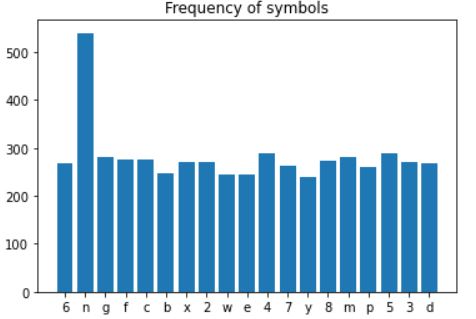
如何提取圖像的數據建立X,y??
# 如何提取圖像 建立 model X 的shape 1070 * 50 * 200 * 1
# y的shape 5 * 1070 * 19
for i, captcha in enumerate(captcha_list):
captcha_code = captcha.split('.')[0]
# cv2.IMREAD_GRAYSCALE 灰度圖
captcha_cv2 = cv2.imread(os.path.join(DIR, captcha),cv2.IMREAD_GRAYSCALE)
# 縮放
captcha_cv2 = captcha_cv2 / 255.0
# print(captcha_cv2.shape) (50, 200)
# 將captcha_cv2的(50, 200) 切換成(50, 200, 1)
captcha_cv2 = np.reshape(captcha_cv2, img_shape)
# (5,19)
targs = np.zeros((len_captcha, len_symbols))
for a, b in enumerate(captcha_code):
targs[a, symbols.index(b)] = 1
X[i] = captcha_cv2
y[:, i] = targs
print("shape of X:", X.shape)
print("shape of y:", y.shape)
輸出如下
print("shape of X:", X.shape)
print("shape of y:", y.shape)
通過Numpy中random 隨機選擇數據,劃分訓練集和測試集
# 生成隨機數
from numpy.random import default_rng
rng = default_rng(seed=1)
test_numbers = rng.choice(1070, size=int(1070*0.3), replace=False)
X_test = X[test_numbers]
X_full = np.delete(X, test_numbers,0)
y_test = y[:,test_numbers]
y_full = np.delete(y, test_numbers,1)
val_numbers = rng.choice(int(1070*0.7), size=int(1070*0.3), replace=False)
X_val = X_full[val_numbers]
X_train = np.delete(X_full, val_numbers,0)
y_val = y_full[:,val_numbers]
y_train = np.delete(y_full, val_numbers,1)
在此驗證碼數據中,容易出現過擬合的現象,你可能會想到添加更多的新數據、 添加正則項等, 但這里使用數據增強的方法,特別是對于機器視覺的任務,數據增強技術尤為重要。
常用的數據增強操作:imgaug庫。imgaug是提供了各種圖像增強操作的python庫 https://github.com/aleju/imgaug。
imgaug幾乎包含了所有主流的數據增強的圖像處理操作, 增強方法詳見github
# Sequential(C, R) 尺寸增加了5倍,
# 選取一系列子增強器C作用于每張圖片的位置,第二個參數表示是否對每個batch的圖片應用不同順序的Augmenter list # rotate=(-8, 8) 旋轉
# iaa.CropAndPad 截取(crop)或者填充(pad),填充時,被填充區域為黑色。
# px: 想要crop(negative values)的或者pad(positive values)的像素點。
# (top, right, bottom, left)
# 當pad_mode=constant的時候選擇填充的值
aug =iaa.Sequential([iaa.CropAndPad(
px=((0, 10), (0, 35), (0, 10), (0, 35)),
pad_mode=['edge'],
pad_cval=1
),iaa.Rotate(rotate=(-8,8))])
X_aug_train = None
y_aug_train = y_train
for i in range(40):
X_aug = aug(images = X_train)
if X_aug_train is not None:
X_aug_train = np.concatenate([X_aug_train, X_aug], axis = 0)
y_aug_train = np.concatenate([y_aug_train, y_train], axis = 1)
else:
X_aug_train = X_aug
讓我們看看一些數據增強的訓練圖像。
fig, ax = plt.subplots(nrows=2, ncols =5, figsize = (16,16))
for i in range(10):
index = np.random.randint(X_aug_train.shape[0])
ax[i//5][i%5].imshow(X_aug_train[index],cmap='gray')


這次使用函數式API創建模型,函數式API是創建模型的另一種方式,它具有更多的靈活性,包括創建更為復雜的模型。
需要定義inputs和outputs
#函數式API模型創建
captcha = Input(shape=(50,200,channels))
x = Conv2D(32, (5,5),padding='valid',activation='relu')(captcha)
x = MaxPooling2D((2,2),padding='same')(x)
x = Conv2D(64, (3,3),padding='same',activation='relu')(x)
x = MaxPooling2D((2,2),padding='same')(x)
x = Conv2D(128, (3,3),padding='same',activation='relu')(x)
maxpool = MaxPooling2D((2,2),padding='same')(x)
outputs = []
for i in range(5):
x = Conv2D(256, (3,3),padding='same',activation='relu')(maxpool)
x = MaxPooling2D((2,2),padding='same')(x)
x = Flatten()(x)
x = Dropout(0.5)(x)
x = BatchNormalization()(x)
x = Dense(64, activation='relu')(x)
x = Dropout(0.5)(x)
x = BatchNormalization()(x)
x = Dense(len_symbols , activation='softmax' , name=f'char_{i+1}')(x)
outputs.append(x)
model = Model(inputs = captcha , outputs=outputs)
# ReduceLROnPlateau更新學習率
reduce_lr = ReduceLROnPlateau(patience =3, factor = 0.5,verbose = 1)
model.compile(loss='categorical_crossentropy', optimizer=Adam(learning_rate=0.0005), metrics=["accuracy"])
# EarlyStopping用于提前停止訓練的callbacks。具體地,可以達到當訓練集上的loss不在減小
earlystopping = EarlyStopping(monitor ="val_loss",
mode ="min", patience = 10,
min_delta = 1e-4,
restore_best_weights = True)
history = model.fit(X_train, [y_train[i] for i in range(5)], batch_size=32, epochs=30, verbose=1, validation_data = (X_val, [y_val[i] for i in range(5)]), callbacks =[earlystopping,reduce_lr])
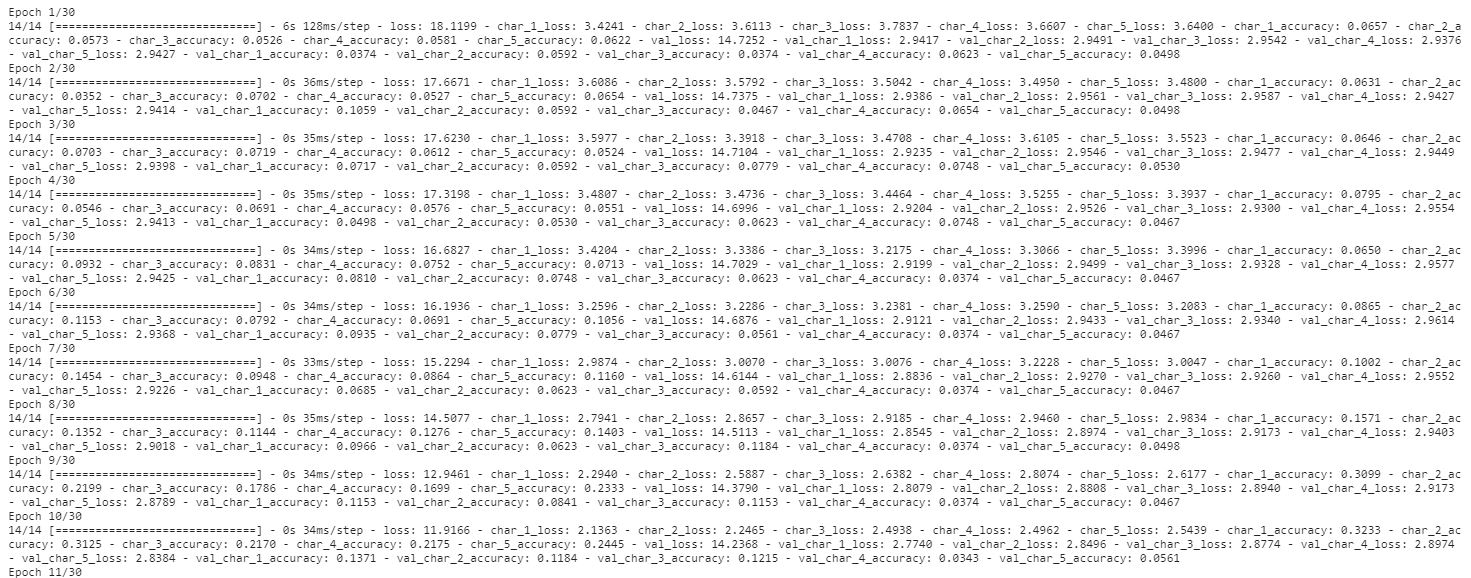
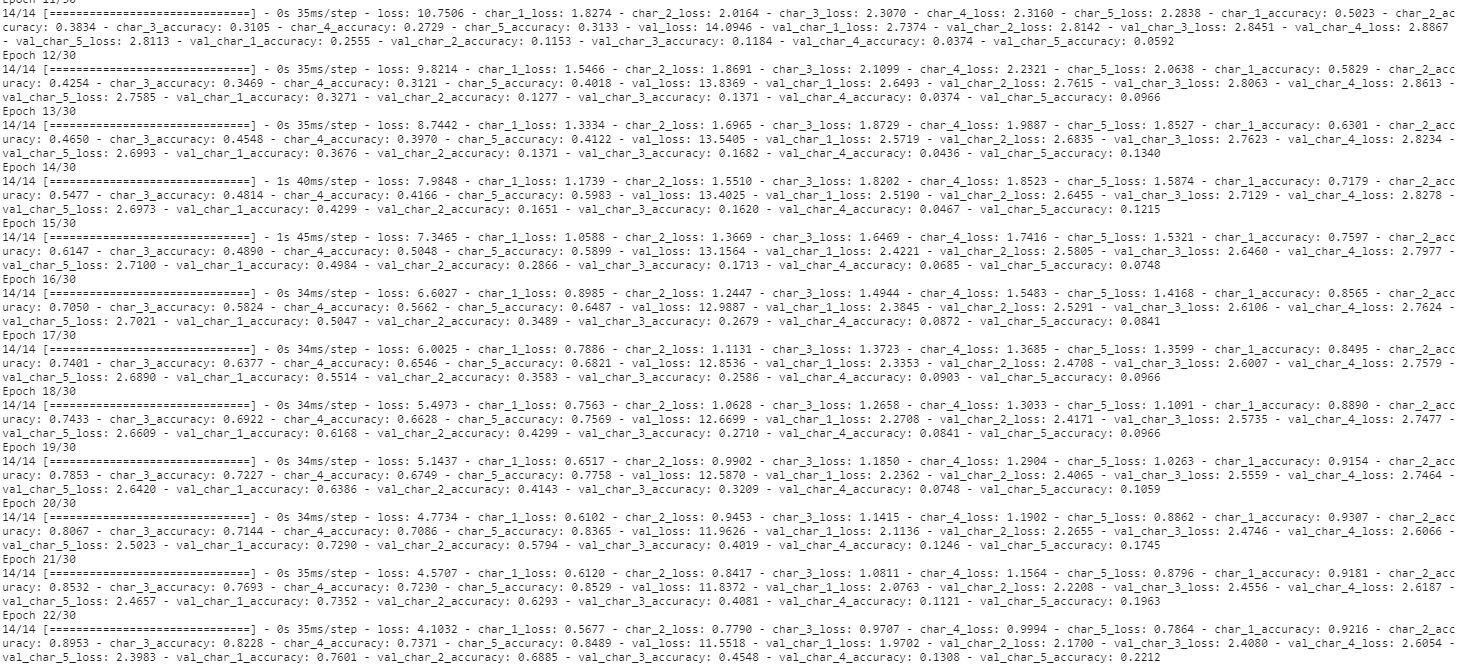

下面對model進行一個測試和評估。
score = model.evaluate(X_test,[y_test[0], y_test[1], y_test[2], y_test[3], y_test[4]],verbose=1)
metrics = ['loss','char_1_loss', 'char_2_loss', 'char_3_loss', 'char_4_loss', 'char_5_loss', 'char_1_acc', 'char_2_acc', 'char_3_acc', 'char_4_acc', 'char_5_acc']
for i,j in zip(metrics, score):
print(f'{i}: {j}')
具體輸出如下:
11/11 [==============================] - 0s 11ms/step - loss: 0.7246 - char_1_loss: 0.0682 - char_2_loss: 0.1066 - char_3_loss: 0.2730 - char_4_loss: 0.2636 - char_5_loss: 0.0132 - char_1_accuracy: 0.9844 - char_2_accuracy: 0.9657 - char_3_accuracy: 0.9408 - char_4_accuracy: 0.9626 - char_5_accuracy: 0.9938
loss: 0.7246273756027222
char_1_loss: 0.06818050146102905
char_2_loss: 0.10664034634828568
char_3_loss: 0.27299806475639343
char_4_loss: 0.26359987258911133
char_5_loss: 0.013208594173192978
char_1_acc: 0.9844236969947815
char_2_acc: 0.9657320976257324
char_3_acc: 0.940809965133667
char_4_acc: 0.9626168012619019
char_5_acc: 0.9937694668769836
字母1到字母5的精確值都大于
繪制loss和score
metrics_df = pd.DataFrame(history.history)
columns = [col for col in metrics_df.columns if 'loss' in col and len(col)>8]
fig = px.line(metrics_df, y = columns)
fig.show()
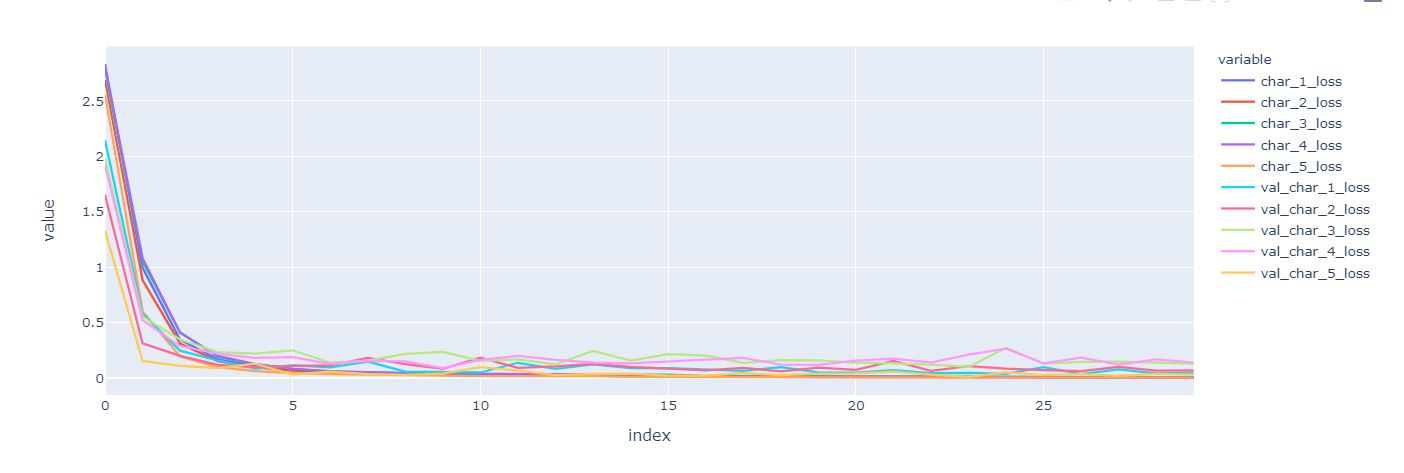
plt.figure(figsize=(15,8))
plt.plot(history.history['loss'])
plt.plot(history.history['val_loss'])
plt.title('model loss')
plt.ylabel('loss')
plt.xlabel('epoch')
plt.legend(['train', 'val'], loc='upper right',prop={'size': 10})
plt.show()

# 預測數據
def predict(captcha):
captcha = np.reshape(captcha , (1, 50,200,channels))
result = model.predict(captcha)
result = np.reshape(result ,(5,len_symbols))
# 取出最大預測中的輸出
label = ''.join([symbols[np.argmax(i)] for i in result])
return label
predict(X_test[2])
# 25277
下面預測所有的數據
actual_pred = []
for i in range(X_test.shape[0]):
actual = ''.join([symbols[i] for i in (np.argmax(y_test[:, i],axis=1))])
pred = predict(X_test[i])
actual_pred.append((actual, pred))
print(actal_pred[:10])
輸出如下:
[('n4b4m', 'n4b4m'), ('42nxy', '42nxy'), ('25257', '25277'), ('cewnm', 'cewnm'), ('w46ep', 'w46ep'), ('cdcb3', 'edcb3'), ('8gf7n', '8gf7n'), ('nny5e', 'nny5e'), ('gm2c2', 'gm2c2'), ('g7fmc', 'g7fmc')]
sameCount = 0
diffCount = 0
letterDiff = {i:0 for i in range(5)}
incorrectness = {i:0 for i in range(1,6)}
for real, pred in actual_pred:
# 預測和輸出相同
if real == pred:
sameCount += 1
else:
# 失敗
diffCount += 1
# 遍歷
incorrectnessPoint = 0
for i in range(5):
if real[i] != pred[i]:
letterDiff[i] += 1
incorrectnessPoint += 1
incorrectness[incorrectnessPoint] += 1
x = ['True predicted', 'False predicted']
y = [sameCount, diffCount]
fig = go.Figure(data=[go.Bar(x = x, y = y)])
fig.show()
在預測數據中,一共有287個數據預測正確。
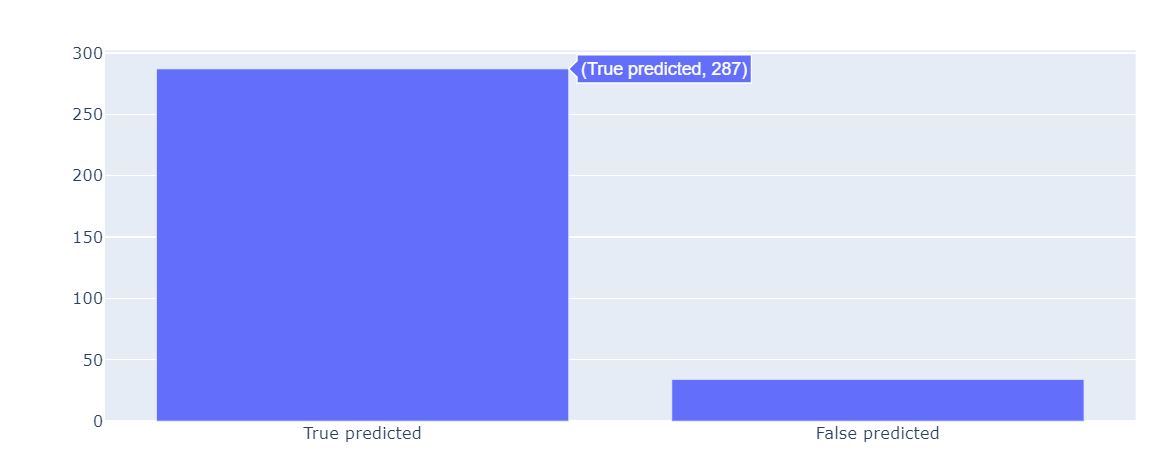
在這里,我們可以看到出現錯誤到底是哪一個index。
x1 = ["Character " + str(x) for x in range(1, 6)]
fig = go.Figure(data=[go.Bar(x = x1, y = list(letterDiff.values()))])
fig.show()
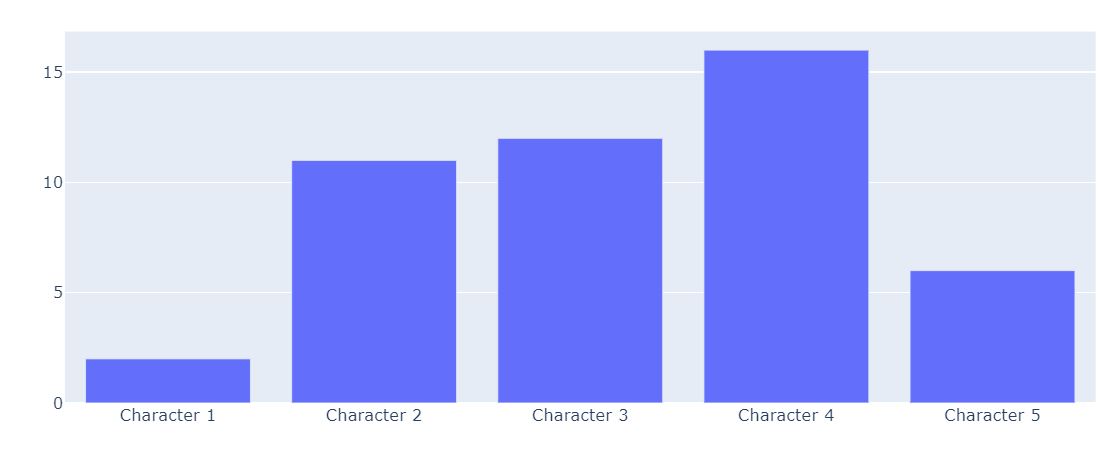
為了計算每個單詞的錯誤數,繪制相關的條形圖。
x2 = [str(x) + " incorrect" for x in incorrectness.keys()]
y2 = list(incorrectness.values())
fig = go.Figure(data=[go.Bar(x = x2, y = y2)])
fig.show()

下面繪制錯誤的驗證碼圖像,并標準正確和錯誤的區別。
fig, ax = plt.subplots(nrows = 8, ncols=4,figsize = (16,20))
count = 0
for i, (actual , pred) in enumerate(actual_pred):
if actual != pred:
img = X_test[i]
try:
ax[count//4][count%4].imshow(img, cmap = 'gray')
ax[count//4][count%4].title.set_text(pred + ' - ' + actual)
count += 1
except:
pass

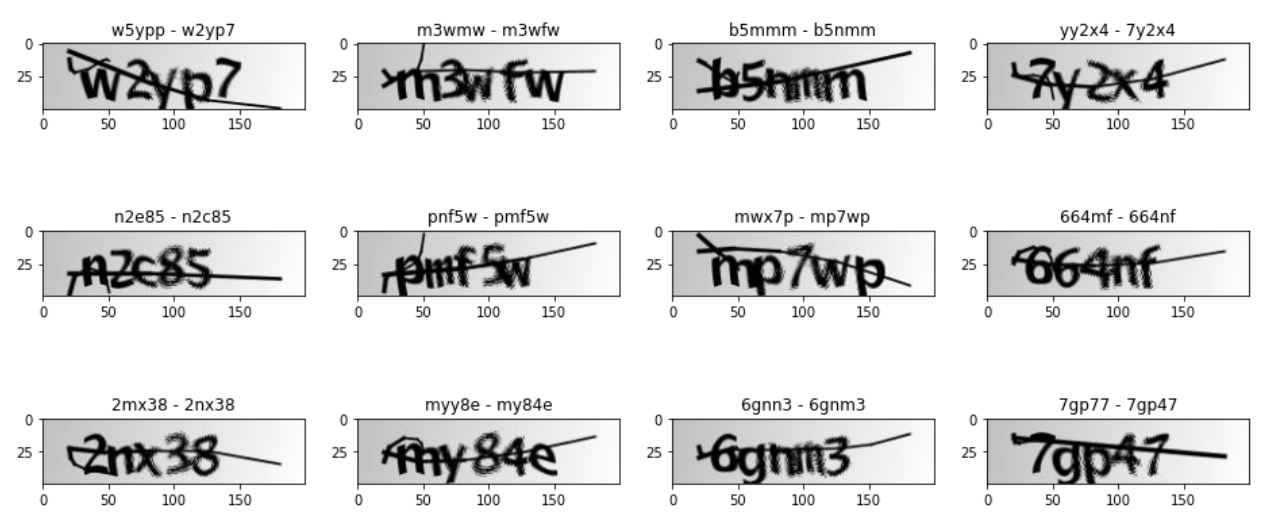

到此這篇關于教你使用TensorFlow2識別驗證碼的文章就介紹到這了,更多相關TensorFlow2識別驗證碼內容請搜索腳本之家以前的文章或繼續瀏覽下面的相關文章希望大家以后多多支持腳本之家!
您可能感興趣的文章:- pytorch_pretrained_bert如何將tensorflow模型轉化為pytorch模型
- TensorFlow中tf.batch_matmul()的用法
- Tensorflow與RNN、雙向LSTM等的踩坑記錄及解決
- tensorflow中的數據類型dtype用法說明
- tensorflow基本操作小白快速構建線性回歸和分類模型